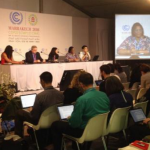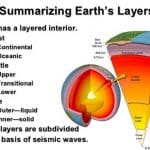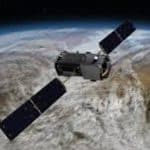Supermoon – A delight for the eyes!
What is Supermoon?
- A supermoon is a natural phenomenon in which there is a coincidence of a full moon or a new moon with the closest approach the Moon makes to the Earth on its elliptical orbit.
- The technical name is the perigee-syzygy of the Earth–Moon–Sun system.
- The name supermoon was coined by astrologer Richard Nolle in 1979, arbitrarily defined as: … a new or full moon which occurs with the Moon at or near (within 90% of) its closest approach to Earth in a given orbit (perigee).
- In short, Earth, Moon and Sun are all in a line, with Moon in its nearest approach to Earth.
- The association of the Moon with both oceanic and crustal tides has led to claims that the supermoon phenomenon may be associated with increased risk of events such as earthquakes and volcanic eruptions, but there is no evidence of such a link.
- The opposite phenomenon, an apogee-syzygy, has been called a micromoon, though this term is not as widespread as supermoon.
- The most recent supermoon occurred on November 14, 2016, the closest to Earth since January 26, 1948.
- The next supermoon like this will not be until November 25, 2034.
- The closest supermoon of the century will occur on December 6, 2052.
- Occasionally, a supermoon coincides with a total lunar eclipse. The most recent occurrence of this was in September 2015, while the next time will be in October 2033.
Fascinating Facts
- The Moon’s distance varies each month between approximately 357,000 and 406,000 kilometres (222,000 and 252,000 mi) because of its elliptical orbit around the Earth.
- To us Earthlings supermoon phenomenon results in 30% brighter and 14% bigger in size of the lunar disk than one at its farthest point, or apogee.
- Perigee is the point at which the Moon is closest in its orbit to the Earth, and syzygy is when the Earth, the Moon and the Sun are aligned, which happens at every full or new moon.
- There has been media speculation that natural disasters, such as the 2011 Tōhoku earthquake and tsunami and the 2004 Indian Ocean earthquake and tsunami, are causally linked with the 1–2 week period surrounding a supermoon.
- A large, 7.5 magnitude earthquake centred 15 km north-east of Culverden, New Zealand at 00:03 NZDT on November 14, 2016, also coincided with a supermoon.
- However, no evidence has been found of any correlation between supermoons with major earthquakes.
- They’re fairly frequent, although November’s supermoon will be a once-in-a-generation sight.
- There are six supermoons in 2016. We’ve already had four, and there was one on December 14.
- Most people know that tides are governed by the gravitational pull of the moon and, to a lesser extent, the sun. Because the sun and moon go through different alignments, this affects the size of the tides.
- The combined effect of the Sun and Moon on the Earth’s oceans, the tide, is greatest when the Moon is either new or full.
- At lunar perigee the tidal force is somewhat stronger, resulting in perigean spring tides. But even at its most powerful this force is still relatively weak causing tidal differences of inches at most.
- As the tidal force follows an inverse-cube law, that force is 19% greater than average. However, because the actual amplitude of tides varies around the world, this may not translate into a direct effect.
- It might look close, but, of course, it’s not that close. November 14’s full moon was the closest in 70 years. The moon came 221,524 miles from Earth – almost touching distance in space terms.
- The closest full moon of the whole of the 21st century will fall on December 6, 2052.
There are lots of other moons too
- Full moon: Moon which comes around every month and light up the night at night.
- Harvest moon: The full moon closest to the autumn equinox.
- Black moon: The second new moon in the same calendar month. The last black moon was at the start of October 2016 and the next one is expected in 2019.
- Blue moon: A phenomenon that occurs when there is a second full moon in one calendar month.
- Blood moon: Also known as a supermoon lunar eclipse. It’s when the shadow of Earth casts a reddish glow on the moon, the result of a rare combination of an eclipse with the closest full moon of the year. There was one in September 2015, and before that in 1982 but the next one won’t be until 2033.
- Strawberry moon: A rare event when there’s a full moon on the same day as the summer solstice. It happened in June 2016 for the first time since 1967 when 17 hours of sunlight gave way to a bright moonlit sky.











